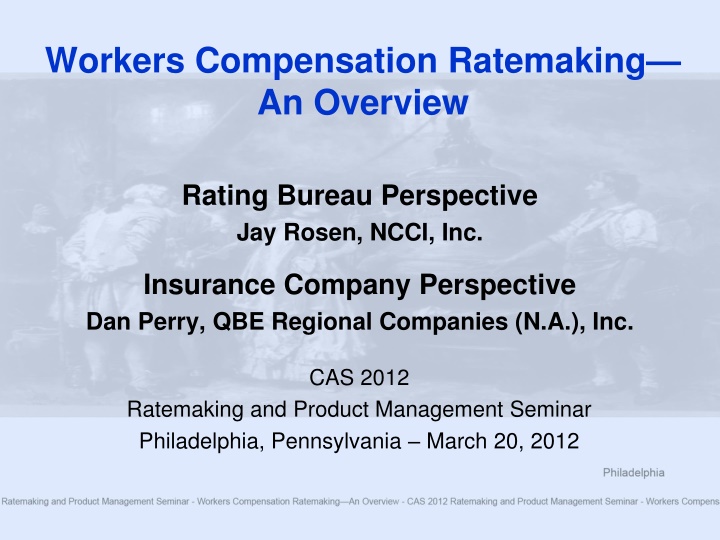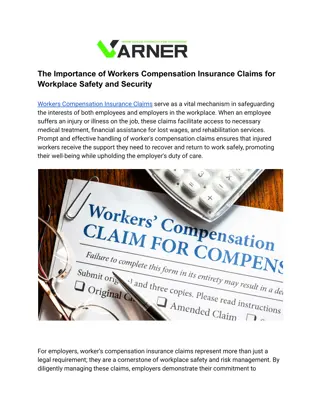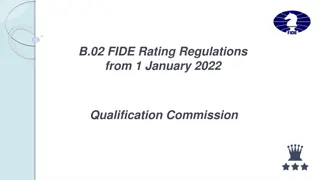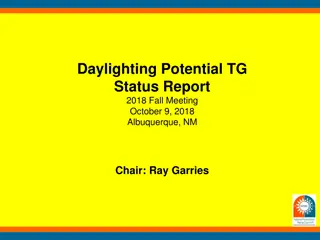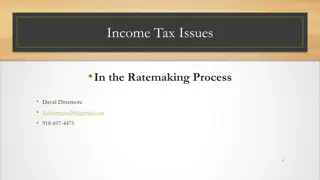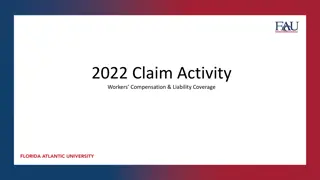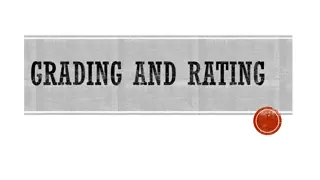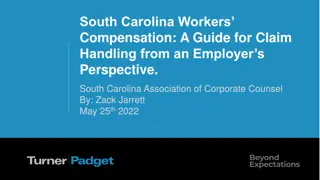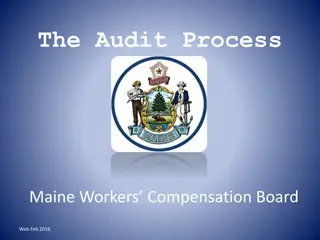Workers Compensation Ratemaking Overview - Rating Bureau Perspective
Gain insights into workers' compensation rate setting from the perspectives of rating bureaus and insurance companies. Explore loss costs, rating laws, databases, and financial aggregate calls guiding the process.
Download Presentation

Please find below an Image/Link to download the presentation.
The content on the website is provided AS IS for your information and personal use only. It may not be sold, licensed, or shared on other websites without obtaining consent from the author.If you encounter any issues during the download, it is possible that the publisher has removed the file from their server.
You are allowed to download the files provided on this website for personal or commercial use, subject to the condition that they are used lawfully. All files are the property of their respective owners.
The content on the website is provided AS IS for your information and personal use only. It may not be sold, licensed, or shared on other websites without obtaining consent from the author.
E N D
Presentation Transcript
Workers Compensation Ratemaking An Overview Rating Bureau Perspective Jay Rosen, NCCI, Inc. Insurance Company Perspective Dan Perry, QBE Regional Companies (N.A.), Inc. CAS 2012 Ratemaking and Product Management Seminar Philadelphia, Pennsylvania March 20, 2012
Workers Compensation Ratemaking An Overview Rating Bureau Perspective
Rating Bureau Perspective Outline Overview of Workers Compensation Insurance NCCI Filing Overall Rate / Loss Cost Level Change Classification Rate / Loss Cost Changes 3
Loss CostsWhat Are They? In general, a loss cost represents a provision for losses and LAE per $100 of payroll for each classification Loss costs are not final rates because they do not include provisions for the remaining expenses (including production expenses, profit and contingencies, etc.) of an insurer 4
Workers Compensation Rating Laws LOSS COST LOSS COST/INDEP RTG BUREAU MONOPOLISTIC RATES RATES/INDEP RTG BUREAU (31) (7) (4) (5) (4) 5
NCCI Workers Compensation Databases Financial Aggregate Calls Used for aggregate ratemaking WC Statistical Plan (WCSP) Used for class ratemaking 6
Financial Aggregate Calls Collected annually Policy and calendar-accident year basis Statewide and assigned risk data Premiums, losses and claim counts Evaluated as of December 31 Purpose Basis for overall aggregate rate indication Research 7
Designated Statistical Reporting (DSR) Level Premium Common benchmark level at which carriers report premium on the financial calls The DSR level represents the approved loss cost and assigned risk rate levels Varies by policy year and state 8
RatemakingThe Big Picture For the upcoming loss cost effective period: Projected losses & Loss Adjustment Expense* Premium at current loss cost level = Indicated overall average loss cost level change * Not all states include loss adjustment expense in the calculation. 9
NCCI Typically Uses the Two Most Recent Policy Years of Data Policy Expiration Date Policy Year 2009 Policy Year 2010 Policy Year 2013 1/1/09 1/1/10 12/31/10 1/1/13 12/31/13 Policy Effective Date 10
Derivation of Projected Losses Adjustments to reported losses: Benefit (loss) on-levels Loss development Trend 11
Benefit Changes Changes that occur subsequent to the filing data must be reflected: Legislated benefit changes Court decisions New regulations 12
Loss On-level Factors Adjust Data to the Current Benefit Level Benefit Change Effective March 1, 2010 Policy Year 2009 Policy Year 2010 Policy Year 2013 1/1/09 1/1/10 12/31/10 1/1/13 12/31/13 Policy Effective Date 13
Loss Development The ultimate cost of a reported claim may not be known for many years. Therefore, an initial estimate of the ultimate settlement value is made at the time the claim is reported. This estimate may change over time as the prognosis of the injury changes, the expected life-span shortens/ lengthens, the cost of medical services increases/ decreases, etc. 14
Loss Development Factors Are Used to Estimate Ultimate Liabilities Over time, the % of ultimate losses that are paid increases IBNR IBNR Case Reserves IBNR Case Reserves Paid Case Reserves Paid Paid . . . Paid PY2009 1st Rpt PY2009 2nd Rpt PY2009 3rd Rpt PY2009 Ultimately . . . IBNR: Reserves set aside for claims that have been Incurred But Not yet Reported. 15
Trend Trend compares movements in indemnity and medical costs to movements in payroll }Trend Benefit Costs Payroll Data in Filing Time Filing Effective 16
Techniques to Measure Trend Fitting curves to Historical Loss Ratios Use of Frequency and Severity Data Econometric Analysis Outside Sources (AHA, DOL) A positive trend assumes that losses are growing faster than wages. A negative trend assumes the opposite. 17
Derivation of Premium at Current Loss Cost Level Adjustments to reported financial data premium: Premium on-levels Policy year premium development 18
Premium On-level Factors Adjust Historical Premium to the Current Approved Level Policy Year 2009 Policy Year 2010 Policy Year 2013 1/1/09 1/1/10 12/31/10 1/1/13 12/31/13 Loss Cost Level Change Effective July 1, 2010 Policy Effective Date 19
Policy Year Premium Development (Due to payroll audits) Last Policy Expires Most Audits Complete Policy Year Jan 1st Dec 31st Dec 31st Mar 31st PY Financial Data 1st Report 20
WC Statistical Plan (WCSP) Data Experience by policy detail Exposure, premium, experience rating modifications Individual claims by injury type Purposes Classification relativities Experience Rating Plan Research 21
Valuation of WCSP Data 3rd 4th 1st 2nd Report Valuation 5th Report Valuation Report Valuation Report Valuation Report Valuation Policy Effective 18 Months 42 Months 66 Months 30 Months 54 Months 22
Distribution of Overall Change to Industry Groups The overall average change is distributed to industry groups and then to individual classes Manufacturing Textiles Cabinets Automobiles Miscellaneous Trucking Logging Surface coal mining Goods & Services Restaurants Retail sales Nursing Contracting Plumbing Roads Houses Office & Clerical Outside sales Clerical office employees 23
State XYZ Changes by Industry Group Overall Change +2.0% Manufacturing +1.3% Contracting +4.4% Office & Clerical -2.1% Goods & Services +0.4% Miscellaneous +1.7% 24
Individual Classifications Five years of WCSP experience used Individual claims are limited Credibility is assigned National data is used in low volume/credibility classes 25
Formula Pure Premiums Indicated Pure Premium (State data, five years) State Z X + National Pure Premium (National data adjusted) National Z X + Present on Rate Level Pure Premium (approved) Remaining Z X Z = Credibility % 26
Test Correction Procedure Iterative process to ensure that: class swing limits are adhered to the Industry Group change is achieved 27
Classification Swing Limits A +25% Individual class loss costs prior to swing limits B Industry Group Change -25% C (A) = Indicated changes exceeding the upper swing limit (B) = Indicated changes within the swing limits (C) = Indicated changes less than the lower swing limit 28
Final Loss Cost Loss Cost including LAE Add in a provision for Loss Adjustment Expense (Expenses of an insurer which are directly chargeable to the settlement of claims such as investigating cases and defending law suits) May also include loss-based assessments Loss Adjustment Expense Developed and Trended Losses 29
Workers Compensation Ratemaking An Overview Insurance Company Perspective
Insurance Company Perspective Outline Expenses Loss Cost Multipliers Company Pricing Programs Predictive Modeling Current Workers Compensation Market 31
Components of a Rate Full Rate Profit & Contingencies Losses Taxes, Licenses & Fees Production & General Expense Loss Adjustment Expenses Loss Adjustment Expense Loss-Based Assessments Developed and Trended Losses Expenses and Profit A provision for each expense item is added to the final loss cost to produce a full manual rate 32
Expense Components Production commissions, premium collection, underwriting Taxes, Licenses, and Fees various premium taxes, bureau and filing fees General policy processing, overhead, premium audits, actuarial Profit and Contingencies combined with investment income 33
Evaluation of the Needs Outside of the Loss Cost Items Always Outside of the Loss Cost Production Taxes, Licenses, and Fees General Profit and Contingencies Items Sometimes Outside of the Loss Cost Loss Adjustment Expenses Loss-Based Assessments Items Rarely Outside of the Loss Cost (MN) Trend Loss Development beyond 8th report 34
Costs as a Percentage of Standard Premium Profit TaxesGeneral Production Sometimes in the Loss Cost Loss Loss Assessments Most of the time in the Loss Cost Loss Adjustment Almost Always in the Loss Cost 35
How to Account for Items Outside of the Loss Cost The Loss Cost Multiplier (LCM) Also known as a Pure Premium Multiplier Loss Cost x LCM = Rate Factor to load loss costs for insurer s expense and profit Must also consider other items not included in the Loss Cost (trend, development, etc.) Insurance companies must file LCMs for approval in loss cost states 36
Derivation of a Loss Cost Multiplier State A: Loss Cost includes Loss, Loss Adjustment Expense, and Assessments State B: Loss Cost includes Loss and Loss Adjustment Expense State C: Loss Cost includes Loss Only In all three cases, loss includes full trend and loss development 37
Derivation of a Loss Cost Multiplier Portion of Standard Premium State A B C Expenses .275 Profit .025 .275 .275 .025 .025 Loss Assessments (% Prem) .020 .020 Loss Adj. Expense (% Prem) .080 Total of Items to Load on Loss Cost .300 Indicated Loss Cost Multiplier 1.429 = 1/(1 - Load Needed) .320 .400 1.471 1.667 38
Derivation of the LCM Alternative Approach Prior methodology assumes that all items included in the LCM are related to Premium Loss Adjustment Expenses and Assessments may not have a stable relationship to Premium An alternative approach for states that require a loading for loss-related items is: LCM = 1 + Loss Related Items (% Loss) 1 - Premium Related Items (% Premium) 39
Derivation of the LCM Alternative Approach For State C in the Prior Example Loss-related expenses total 10% of premium Loss equals 60% of premium Premium-related expenses total 30% of premium 1 - (30%) 1 + (10% / 60%) LCM = = 1.667 The two methods are mathematically equivalent, but this approach may produce more stable results over time 40
Derivation of the LCM Alternative Approach For State D, a new Example Year 1 58.5% Year 2 87.8% Year 3 Average 52.0% Selection Loss Ratio 65.0% LAE Ratio 11.7% 20.0% 17.6% 20.0% 10.4% 20.0% 13.0% 20.0% 13.0% 20.0% % Loss Commission U/W Exp Tax Profit 8.0% 11.0% 3.0% 7.8% 8.0% 11.0% 3.0% -27.3% 8.0% 11.0% 3.0% 15.6% 8.0% 11.0% 3.0% 0.0% 8.0% 11.0% 3.0% 2.5% 1.538 1.538 1.600 1.589 LCM using premium-based method: LCM using alternative method: 41
The LCM + The LCM, as originally defined, requires the use of expense constants and premium discounts to more accurately charge for individual risks There is a method that can accomplish the same goal without the need for these two other components and can be developed by individual companies Disclaimer: All of the information that follows is completely fictitious and is not meant to resemble any actual carrier s data or experience 42
The LCM + First, let s make some basic assumptions General Information Class code Bureau Loss Cost Loss Adj Exp 1234 $5.00 17.0% as pct of loss Other expenses/costs Premium tax Variable U/W Fixed U/W Profit 3.0% as pct of final premium 5.0% as pct of final premium $700 per policy 0.0% as pct of final premium U/W expense = production and general expense 43
The LCM + Policy Specific Information Policy Number 1 2 3 4 5 6 7 8 9 10 11 12 Exposure (Payroll) (% final prem) 50,000 100,000 150,000 200,000 500,000 600,000 700,000 800,000 1,000,000 1,500,000 2,000,000 2,500,000 Commission 12.0% 12.0% 12.0% 12.0% 9.0% 9.0% 9.0% 9.0% 6.0% 6.0% 6.0% 6.0% 44
The LCM + Premium development formula Premium = Payroll/100 x Loss Cost + Fixed Expense 1- sum of Premium variable items* * Premium variable items are variable underwriting expense, tax, commission, and profit. 45
The LCM + Implied Loss+LAE 2,500 5,000 7,500 10,000 25,000 30,000 35,000 40,000 50,000 75,000 100,000 125,000 505,000 Fixed Variable Expense 200 356 513 669 1,548 1,849 2,151 2,452 2,948 4,401 5,855 7,308 30,249 Needed Premium 4,000 7,125 10,250 13,375 30,964 36,988 43,012 49,036 58,953 88,023 117,093 146,163 604,983 Policy Number 1 2 3 4 5 6 7 8 9 10 11 12 Total Expense 700 700 700 700 700 700 700 700 700 700 700 700 8,400 Tax 120 214 308 401 929 1,110 1,290 1,471 1,769 2,641 3,513 4,385 18,149 Commission 480 855 1,230 1,605 2,787 3,329 3,871 4,413 3,537 5,281 7,026 8,770 43,184 46
The LCM + Determination of LCM - Traditional Method Premium 604,983 Pct of Prem UW Expense Tax Commission Total 38,649 18,149 43,184 99,983 6.4% 3.0% 7.1% 16.5% Implied LCM 1.198 = 1 / (1 - 16.5%) 47
The LCM + Implied Loss+LAE 2,500 5,000 7,500 10,000 25,000 30,000 35,000 40,000 50,000 75,000 100,000 125,000 505,000 Resulting Premium 2,995 5,990 8,985 11,980 29,950 35,940 41,929 47,919 59,899 89,849 119,799 149,748 604,983 Needed Premium 4,000 7,125 10,250 13,375 30,964 36,988 43,012 49,036 58,953 88,023 117,093 146,163 604,983 Percent Difference -25.1% -15.9% -12.3% -10.4% -3.3% -2.8% -2.5% -2.3% Policy Number 1 2 3 4 5 6 7 8 9 10 11 12 Total LCM 1.198 1.198 1.198 1.198 1.198 1.198 1.198 1.198 1.198 1.198 1.198 1.198 1.6% 2.1% 2.3% 2.5% Note: This is why there are premium discounts and expense constants in Workers Compensation. However, the following will show a direct method to calculate these and the final premium. 48
The LCM + Expenses come in two forms: those that vary with premium and those that are fixed with the policy. They are accounted for by the Variable Expense Multiplier and the Fixed Expense Load. The Variable Expense Multiplier (VEM) accounts for expenses that vary with premium. VEM = 1 1- sum of Premium variable items Variable Expenses 20.0% 17.0% 14.0% Policy Number 1 - 4 5 - 8 9 - 12 VEM 1.250 1.205 1.163 49
The LCM + The Fixed Expense Load (FEL) is designed to account for expenses that are fixed with the policy. FEL = Fixed expense dollars per policy 1- sum of Premium variable items or FEL = Fixed expense dollars per policy x VEM The VEM is needed to reflect the fact that we will still pay tax, commissions, etc. on the premium collected due to the fixed expense load. Fixed Expenses 700 700 700 Policy Number 1 - 4 5 - 8 9 - 12 VEM 1.250 1.205 1.163 FEL 875 843 814 50
